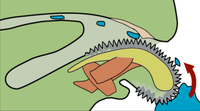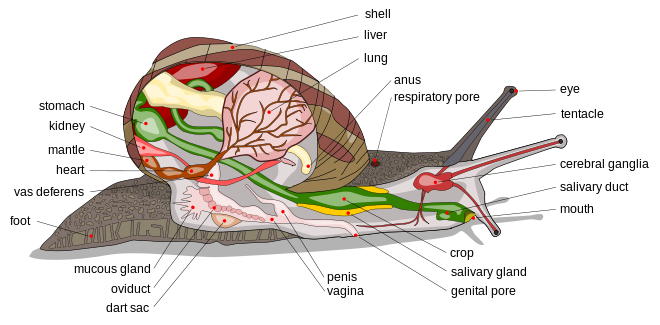Body Plan
The body plans for all terrestrial snails
are generally the same. They consist of a shell, the foot,
mantle, visceral mass, circulatory system, digestive system,
reproductive system, radula, sensory organs, and a nervous
system.
Shell: Made of calcium-carbonate and used to protect the internal organs (Hickman et al., 2011).
Foot: A ventral muscle used for locomotion.
Mantle: A sheath of skin lining the shell that secretes the shell (Hickman et al., 2011).
Visceral Mass: All the internal organs and external gill, if present (Hickman et al., 2011).
Circulatory System:
Most mollusks have an open circulatory system which means that
the blood doesn’t stay within vessels and the heart (Hickman
et al., 2011). It travels throughout the body going through
channels and sinuses in the tissues, called the hemocoel, after
being pumped out by the heart (Hickman
et al., 2011). They also have a lung in the mantle cavity
and breathe with their pneumostome (Hickman
et al., 2011).
Digestive System:
The digestive system has similarities to humans in that they
have intestines, a stomach, a kidney, a liver, and an anus (Hickman
et al., 2011). However, their anus can sometimes end up
above their mouths via torsion (Hickman
et al., 2011). Torsion is the twisting of the visceral mass
that occurs during development (Hickman
et al., 2011).

Radula: This is part of the mouth used for scraping or tearing anything from flesh of organisms to the algae off of surfaces (Hickman et al., 2011).
Sensory Organs:
The sensory organs on mollusks or well developed
(Hickman
et al., 2011). Snails have two pairs of tentacles, one
having eyes on the end with photosensory cells and the other
uses chemosensory cells (Hickman et
al., 2011).
Nervous System: Snail nervous systems are well developed as they have a cerebral ganglion and nerve cells (Hickman et al., 2011).
